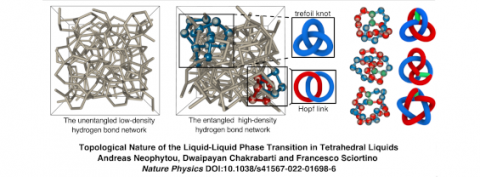Topological Nature of the Liquid-Liquid Phase Transition in Tetrahedral Liquids

Topological Nature of the Liquid-Liquid Phase Transition in Tetrahedral Liquids by Andreas Neophytou, Dwaipayan Chakrabarti and Francesco Sciortino Nature Physics DOI:10.1038/s41567-022-01698-6 Back in 1992, a phase transition was suggested to exist in supercooled water, between two liquids of different density and local structure. Being in deep supercooling conditions, this liquid-liquid phase transition is “hidden” and much is still unknown about it.
Now a team of researchers from the University of Birmingham and Sapienza Università di Roma, throw fundamental insight into what features distinguish the two liquids at the microscopic level. This evidence, published in Nature Physics (https://www.nature.com/articles/s41567-022-01698-6), represents a significant step forward. In this novel computational study, the authors find that the water molecules in the high-density liquid form arrangements that are considered to be "topologically complex", such as a trefoil knot (think of the molecules arranged in such a way that they resemble a pretzel) or a Hopf link (think of two links in a steel chain). The molecules in the high-density liquid are thus said to be entangled. In contrast, the molecules in the low-density liquid mostly form simple rings, and hence the molecules in the low-density liquid are unentangled. The lead author, Andreas Neophytou, a PhD student at the University of Birmingham says that “this insight has provided us with a completely fresh take on what is now a 30-year old research problem, and will hopefully be just a new beginning.” The team of researchers first uncovered the topological distinction of the two liquids in a colloidal model of water, and then in two widely used molecular models of water, using computer simulations. Colloids are particles that can be a thousand times larger than a single water molecule. By virtue of their relatively bigger size, and hence slower movements, colloids are often referred to as “big atoms” and used to observe and understand physical phenomena that also occur at the much smaller atomic and molecular length scales.
Pablo Debenedetti, a professor of chemical and biological engineering at Princeton University in the US and a world-leading expert in this area of research, remarks: “This beautiful computational work uncovers the topological basis underlying the existence of different liquid phases in the same network-forming substance.” He adds: “In so doing, it substantially enriches and deepens our understanding of a phenomenon that abundant experimental and computational evidence increasingly suggests is central to the physics of that most important of liquids: water.” Christian Micheletti, a professor at International School for Advanced Studies in Trieste, Italy, whose current research interest lies in understanding the impact of entanglement, especially knots and links, on the static, kinetics and functionality of biopolymers, remarks: “With this single paper, Neophytou et al. made several breakthroughs that will be consequential across diverse scientific areas. First, their elegant and experimentally amenable colloidal model for water opens entirely new perspectives for large-scale studies of liquids. Beyond this, they give very strong evidence that phase transitions that may be elusive to traditional analysis of the local structure of liquids are instead readily picked up by tracking the knots and links in the bond network of the liquid. The idea of searching for such intricacies in the somewhat abstract space of pathways running along transient molecular bonds is a very powerful one, and I expect it will be widely adopted to study complex molecular systems.”
Francesco Sciortino and Dwaipayan Chakrabarti acknowledge support from the Royal Society via International Exchanges Award, which enabled the international collaboration between the researchers in the UK and Italy, the EPSRC Centre for Doctoral Training in Topological Design at the University of Birmingham and the Italian Ministero Istruzione Università Ricerca – Progetti di Rilevante Interesse Nazionale.
Authors:
Andreas Neophytou, Dwaipayan Chakrabarti and Francesco Sciortino
Reference:
Nature Physics
